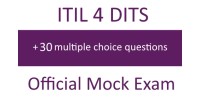Exam Glossary
| Term | Main definition |
|---|---|
| machine learning | An applied form of artificial intelligence, based on the principle of systems responding to data, and adapting their actions and outputs as they are continually exposed to more of it. |
| maintainability | The ease with which a service or other entity can be repaired ormodified. |
| major incident | An incident with significant business impact, requiring an immediate coordinated resolution. |
| management | Coordinated activities to define, control, supervise, and improve something. |
| management system | Interrelated or interacting elements that establish policy and objectives and enable the achievement of those objectives. |
| market disruption | Disruption that occurs when digital technology introduces a change that impacts a particular market or market segment. |
| maturity | A measure of the reliability, efficiency and effectiveness of an organization, practice, or process. |
| mean time between failures MTBF | A metric of how frequently a service or other configuration item fails. |
| mean time to restore service MTRS | A metric of how quickly a service is restored after a failure. |
| measurement | A means of decreasing uncertainty based on one or more observations that are expressed in quantifiable units. |
| measurement and reporting | The practice of supporting good decision-making and continual improvement by decreasing levels of uncertainty. |
| mental model | An explanation of someone’s understanding of how something works in the surrounding world. |
| metric | A measurement or calculation that is monitored or reported for management and improvement. |
| microservices | A variation of the service-oriented architecture in which an application is designed and developed as a set of small, loosely coupled services, each running in its own process and using lightweight mechanisms to communicate. |
| minimum viable approach | A technique of providing users with the minimum set of capabilities to enable rapid assessment and learning. |






